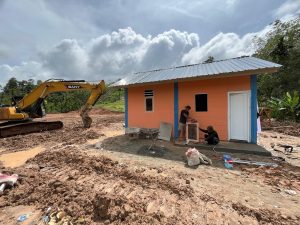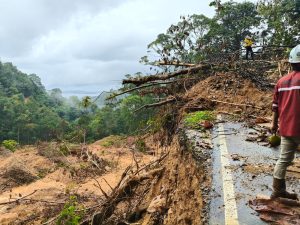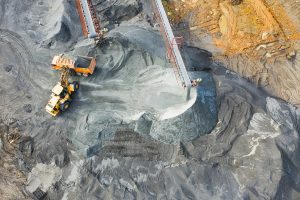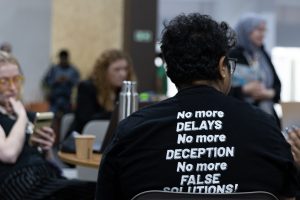by Fadiyah Alaidrus
Most of us on this Earth can feel the temperature rising these past few years. Not only an increase in temperature, but also more frequent climate-related natural disasters. These phenomena impact a wide range of issues, from the increase in disease outbreaks, lowering water quality and quantity, species extinctions, to the sinking of small islands, to name a few.
Indonesia ranks as one of the largest contributors of greenhouse gases (GHG) emissions in the world which drives an increase in temperature. However, Indonesia is committed to reducing the Earth’s temperature by 1.5°C through a 29% reduction in GHG by its own efforts or 41% with international assistance by 2030, a commitment many critics deemed as ‘not ambitious enough’.
To achieve this target, the Government of Indonesia, through the National Development Planning Agency (Bappenas), has included a low-carbon development plan (PRK) as a priority in Indonesia’s 2020-2024 National Medium-Term Development Plan (RPJMN).
“In low-carbon development, we can not merely reduce emissions, but also avoid trade-offs between our economic development and efforts to reduce emissions,” Bappenas Environment Director Medrilzam stated in a webinar organised by the Institute for Essential Services Reform (IESR) on April 28, 2021.
Medrilzam explained that as the basis for a number of low carbon development programs and policies, it is necessary to strengthen policies in at least four areas. First, the energy sector, which includes reducing energy intensity, new and renewable energy, and transitioning to electric vehicles. Second, the land sector, which includes forests and peatlands reforestation and mangrove rehabilitation, prevention of deforestation, and prevention of land and peat fires.
The third policy is on waste, which includes debarking on a journey towards a circular economy or increasing the efficiency of natural resources utilisation with waste production and management and reduction of liquid waste production. Lastly, fiscal policy, including the abolition of fuel subsidies and the implementation of a Carbon Tax.
The importance of private sector inclusion
To implement low carbon development, Medrilzam said, it is necessary to involve all stakeholders, from the government, the community, academia, to the private sector. However, the involvement of the private sector is still low, especially in the energy sector.
“We have to admit that the role of the private sector in climate change is still minimal, it’s still not very visible, especially in the energy sector. From Bappenas’ projections, at Bappenas, going forward the energy sector will be the spearhead for reducing emissions,” he explained, adding that “emissions from the energy sector are expected to be enormous in the future because they still use dirty energy sources.”
Meanwhile, Medrilzam said that the involvement of the private sector is very important because it is impossible for the government to act alone in the low carbon development without their involvement. He said that subsidies for green energy are low and are still far behind compared to fossil fuels.
The recent Intergovernmental Panel on Climate Change (IPCC) report states that coal and gas powered plants must be closed within the next decade to avoid climate damage. Meanwhile, the majority of energy in Indonesia comes from coal and oil, and is controlled by the private sector.
IESR Executive Director Fabby Tumiwa said that the private sector has an important and key role in low carbon development. He believed that economic growth cannot be separated from economic activities carried out by the community and the private sector.
However, Tumiwa sees that the involvement of the private sector in low carbon development has not been consistent and questioned the alignment of their vision and goals on low carbon development. “If they don’t see it as a strategy or their business goal, then it won’t be possible,” explained Tumiwa when contacted on Saturday (14/8/2021).
The government, especially through Bappenas, needs to communicate and disseminate information about the low carbon development to the private sector, he said. In addition, the government also needs to encourage a business climate that supports the achievement of targets in the RPJMN through policy making based on low carbon development.
Tumiwa said that the government needs strong regulation to achieve the low carbon development plans and needs “to encourage technical sectors or ministries for more socialization, and harmonize policies and regulations to encourage economic actors to reduce greenhouse gas emissions or reduce the negative impact of their activities on the environment.”
Confusing regulations
The large number of parties and existing policies related to climate mitigation and adaptation, including in low carbon development contributes to the confusion. In the energy sector, there are a number of institutions authorized in the planning to implementation, starting from Bappenas to the National Energy Council (DEN). Bappenas designed the low carbon development scheme in the RPJMN, including for the energy sector, while DEN designed the National Energy Policy (KEN) and the General National Energy Plan (RUEN).
Tumiwa said the relation between RUEN and RPJMN is unclear. “In the implementation, who will evaluate whom?” he said.
Tumiwa said that many planning documents, both national and sectoral, would overlap with each other, or even completely out of sync. He said that to avoid miscommunications that may hinder the achievement of low carbon development, the government needs to synchronize these documents, and create a clear coordination flow.
Apart from the potential confusion in the implementation, the regulation also sparked questions in its effectiveness in addressing injustice within affected communities in the natural resources sector.
Senior Researcher for Lokahita Center for Ecology and Geospatial Research, Dian Afriyanie called on the government to also include injustices that have emerged so far in the existing low carbon development strategy, and not only addressing economic and environmental issues.
“At least for me, I have not seen how this strategy can be implemented in real terms, especially to overcome injustice,” said Afriyanie in the IESR webinar.
She said that some of the injustices happen in the forestry and the energy sector. “For example, communities’ rights in forest land and plantations still differ far with land ownership owned by companies, even though the government recently has redistributed land rights,” she said.
“Going forward, the strategy on reforestation and forest and land rehabilitation also needs to consider local or indigenous people’s access to their sources of life,” Afriyanie concluded.














